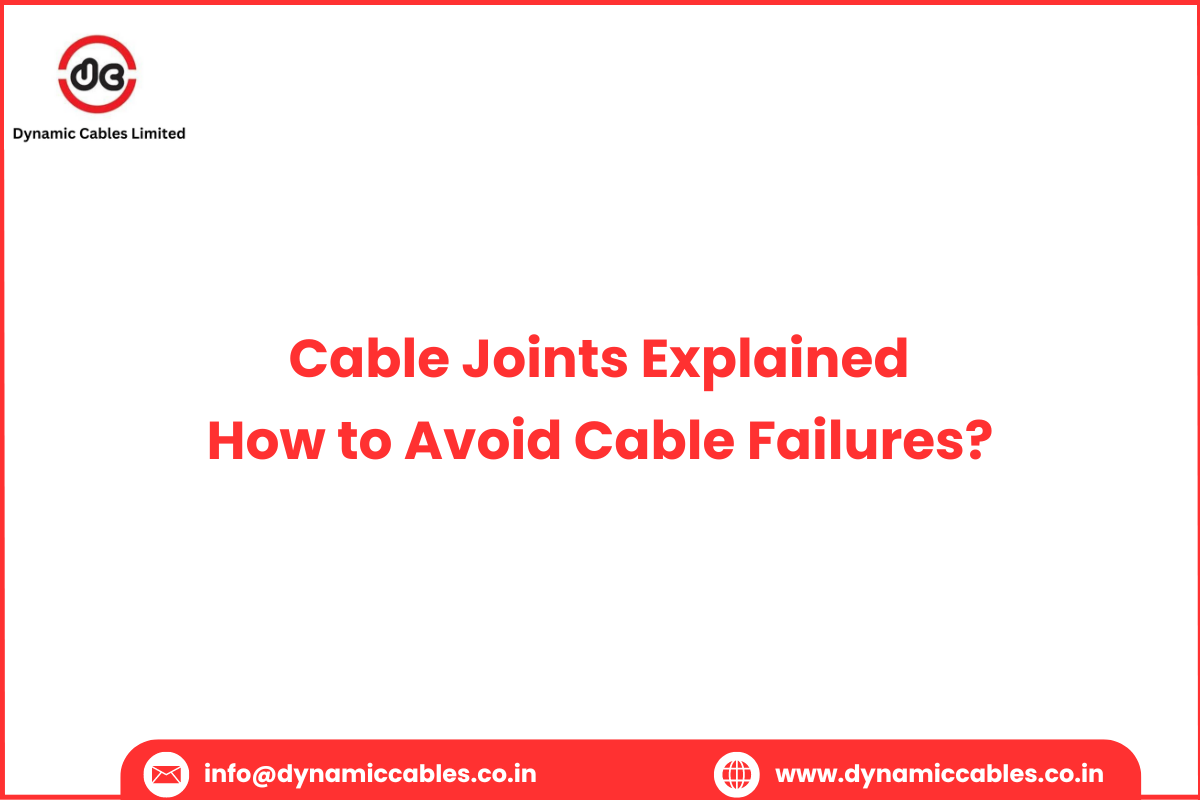- An ISO 9001:2015, 14001:2015 & 45001:2018 Company

What are Cable Joints? How to Reduce Cable Joint Failure?
Cable joints are critical components in electrical systems, allowing the connection and continuation of electrical cables. They play a pivotal role in ensuring the reliability and efficiency of power distribution networks. However, cable joints can fail if not properly installed and maintained. In this article, we will read - What are cable joints? Types of cable joints, common causes of cable joint failure, and practical steps to minimise these failures. By understanding and addressing all these issues, we can enhance the performance and longevity of electrical systems.
What are Cable Joints?
Cable joints are devices or assemblies that help to connect two or more electrical cables. They ensure a continuous electrical path, allowing electricity to flow seamlessly between different sections of the cable network. It helps to create a constant and reliable electrical path. Cable joints are typically used in various applications, including power distribution and industrial settings.
What are the Different Types of Cable Joints?
There are different types of cable joints. These are as follows.
- Transition Joint: Transition joints are designed to connect cables of different types or sizes, ensuring a seamless and compatible connection. They are versatile and can handle all voltage levels and various construction and insulation materials. For example, they can safely link a single-core cable to a three-core cable.
- Heat Shrink Joints: Heat-shrink joints use heat-shrinkable materials that, when heated, shrink tightly around the cable to form a secure, protective seal. This method provides insulation and protection against environmental factors like moisture and dust. Heat-shrink joints are commonly used for their reliability and ease of installation in various applications.
- Cold Shrink Joints: Cold-shrink joints involve pre-stretched, elastic materials that are slipped over the cable and then allowed to shrink naturally without heat. Cold shrink joints are easier to install than heat shrink joints, as they do not require a heat source. This method offers a quick and straightforward installation process with a tight, protective seal that is effective against environmental conditions. Cold-shrink joints are often preferred for their convenience and ease of use in specific installations.
- Pot End Joints: Pot end joints terminate cables, providing a secure and insulated end connection. They consist of a pot-shaped housing that encapsulates the end of the cable, ensuring protection and stability.
- Straight Joints: Straight-through joints connect two lengths of cable of the same type and diameter, ensuring a continuous and reliable electrical path. They are essential for extending cable lengths in power distribution and are used in underground and overhead systems.
- Branch Joints: Branch joints create diverging points from a central cable, allowing the distribution of power or data to multiple pathways. They help expand networks, such as distributing power to buildings or street lighting.
What are the Common Causes of Cable Joint Failure?
Some of the most common causes lead to cable joint failure.
- Improper Installation: Incorrect installation procedures, such as inadequate preparation of cable ends or poor alignment, can lead to joint failure. Ensuring that joints are installed according to manufacturer guidelines is crucial.
- Environmental Factors: Exposure to moisture, chemicals, and extreme temperatures can degrade the joint materials and cause failures.
- Incorrect Cable Jointing Materials: Using materials incompatible with the cable type or voltage rating can lead to joint failure. It's crucial to select the suitable materials as the manufacturer specifies to ensure a secure and reliable connection.
- Lack of Jointer Tools: Failing to use the proper tools for cable jointing can result in poor installation quality. Using incorrect or inadequate tools can lead to improper connections, which may cause electrical faults or mechanical stress on the joints.
How to Reduce Cable Joint Failure?
Here are some of the following tips to help you to reduce cable joint failure.
- Follow Manufacturer Instructions: Always follow the installation guidelines provided by the manufacturer. Proper installation techniques and materials are critical for ensuring the reliability of cable joints.
- Always use high-quality materials: Choose cable joints made from durable and compatible materials suitable for the specific application and environment.
- Regular inspection and maintenance: Implement a proactive maintenance program that includes regular inspections, testing, and preventive maintenance of cable joints.
- Proper Training: Ensure cable joint installation and maintenance personnel are appropriately trained and knowledgeable about best practices and safety procedures.
- Proper cable handling and protection: Handle cables carefully during installation and protect them from mechanical damage, moisture and other environmental factors.
Let's end up with
Cable joints are crucial for the reliability of electrical networks but can fail, causing costly disruptions. To prevent failures, focus on proper installation, select high-quality materials, and conduct regular maintenance and monitoring. By following these best practices, you can significantly improve the performance and longevity of your cable system, ensuring a stable and efficient electrical network. Prioritising these measures will help minimise the risk of cable joint failures and maintain the continuity of your electrical systems.
You may also like:What Specific Tests are Conducted to Ensure Cable Reliability?
Why is Quality Control and Testing Crucial for Cable Reliability?
What are the Safety Standards and Regulations in the Cable Industry?
 English
English


 C701, Tower-C, Noida One
C701, Tower-C, Noida One
